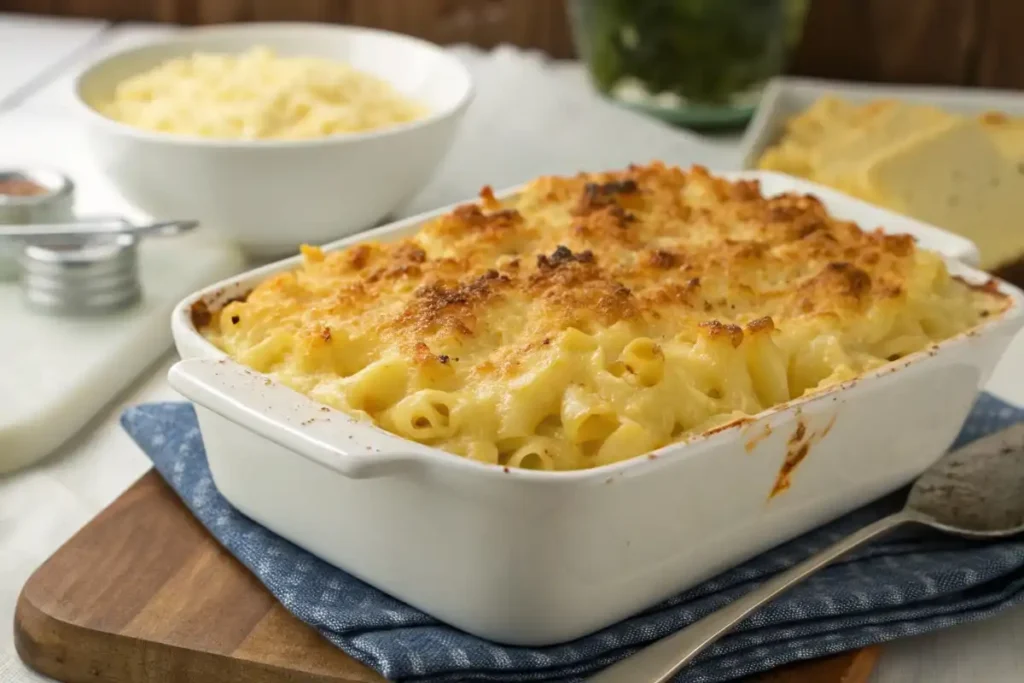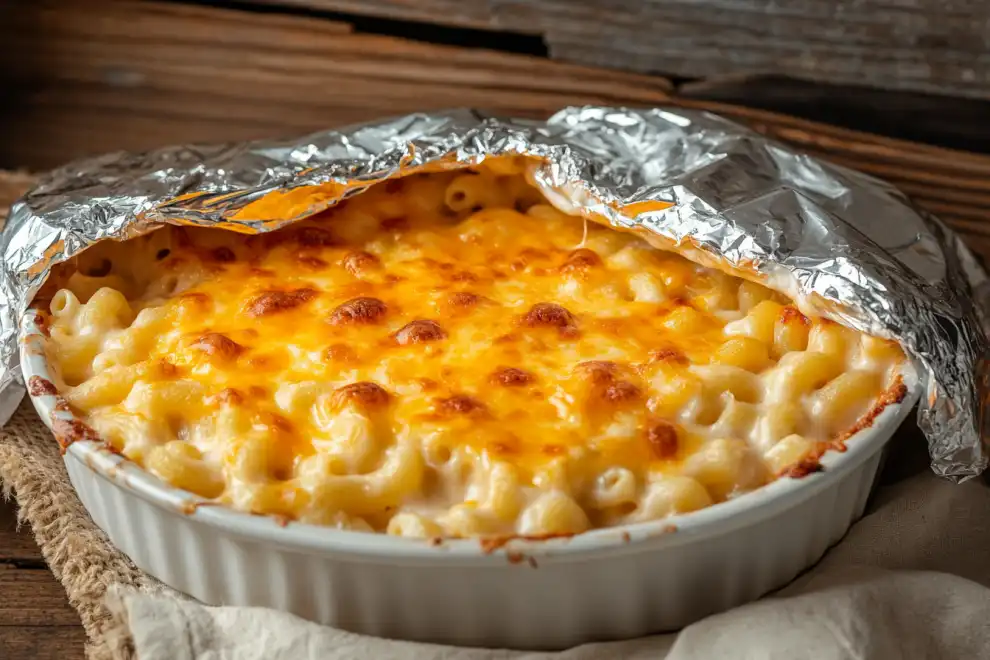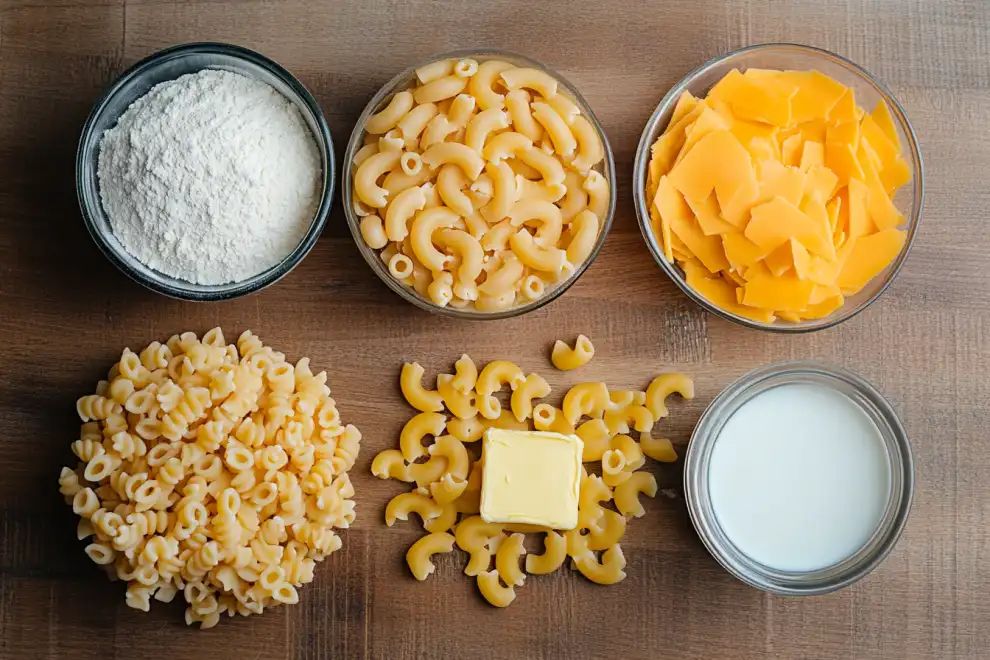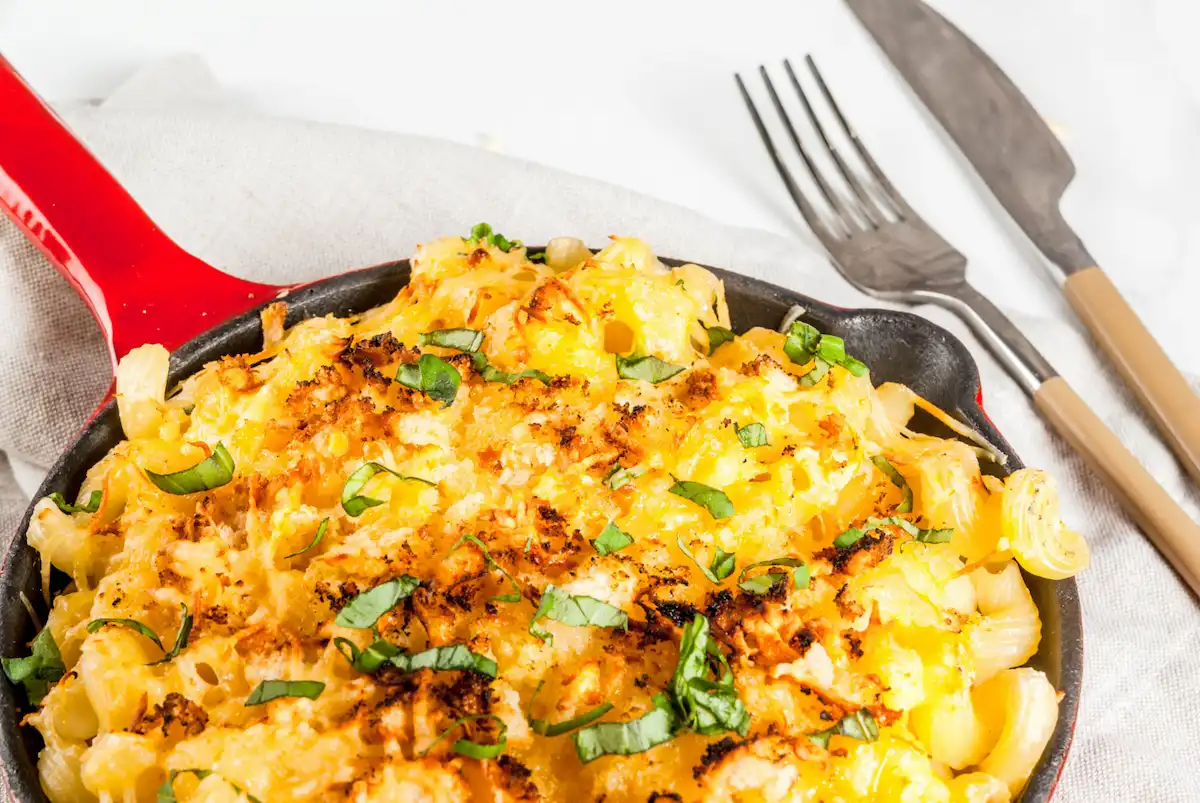Discover how baking macaroni and cheese uncovered can create a crispy, flavorful dish that never fails to impress.
Introduction
Are you supposed to cover macaroni and cheese when you bake it? This question often sparks debate among home cooks and food lovers. Macaroni and cheese is famous for its rich sauce, golden crust, and heartwarming nostalgia. Therefore, the way you bake it can make a big difference in its final taste and texture. Some people believe that covering the casserole creates a creamier dish, while others insist that uncovering it develops a crisp top that keeps everyone coming back for seconds. Throughout this article, we will delve into both approaches, compare their benefits, and discuss how to avoid common pitfalls. In addition, you will learn a foolproof recipe, discover creative variations, and explore the best techniques for an unforgettable mac and cheese experience.

Table of Contents
Baked Macaroni and Cheese: An Enduring Tradition
Macaroni and cheese, often shortened to “mac and cheese,” has been an American favorite for generations. However, the concept of combining pasta with cheese originated in Europe centuries ago. Over time, immigrants brought their food traditions to the United States, where this dish evolved into the beloved casserole we know and adore today.
A Brief History of Mac and Cheese
Although it is difficult to pinpoint the exact moment macaroni and cheese became mainstream, many credit Thomas Jefferson with popularizing macaroni after tasting pasta during his time in Europe. As more cookbooks circulated in the U.S., recipes for macaroni and cheese increasingly appeared, solidifying this dish as a classic comfort food. Ultimately, the convenience of boxed mac and cheese in the mid-1900s skyrocketed its popularity. However, nothing compares to a homemade version pulled fresh from the oven, especially one that strikes a perfect balance between creamy sauce and a crunchy crust.
The Baking Element
Baking macaroni and cheese generally involves combining cooked pasta with a velvety cheese sauce, then placing it in a casserole dish before popping it in the oven. This crucial step helps meld flavors, further thickens the sauce, and can develop a tempting, caramelized top. Because the top crust can be a deal-breaker for many, the debate regarding whether to cover the dish intensifies. Therefore, answering the question “Are you supposed to cover macaroni and cheese when you bake it?” becomes vital for anyone hoping to master this all-time favorite.
For a traditional take on this comforting meal, check out our Old-Fashioned Baked Macaroni and Cheese recipe. It offers insights into classic baking techniques and highlights the dish’s enduring appeal.
The Case for Covering Macaroni and Cheese
Some home cooks firmly believe that covering your mac and cheese during baking results in a creamier interior. However, the approach has specific advantages and drawbacks. Understanding both can help you decide if this method meets your personal taste.
Retaining Moisture for Creaminess
When mac and cheese is covered, a lid or layer of foil traps steam within the casserole. Therefore, the sauce’s moisture remains largely intact instead of evaporating. For those who love an extra-saucy mac and cheese, this method might seem like the best option. By keeping steam in, the pasta is less prone to drying out, and the cheese sauce tends to stay smooth.
Even Heat Distribution
Another reason to cover your mac and cheese is the more uniform cooking environment that results from sealing the dish. This stable heat can be particularly appealing if you use heavier cheeses or if you bake at a higher temperature, reducing the likelihood of scorching spots. In addition, a cover can help the casserole heat through more quickly.
Common Pitfalls
Unfortunately, covering the dish sometimes leads to a lackluster crust. The steam can create a layer of condensation under the foil, which drips onto the cheese topping. Consequently, those who crave a golden, crispy surface might be disappointed. Furthermore, the top could turn out less flavorful because browning promotes rich flavors known as the Maillard reaction. Therefore, you might miss out on the toasty, caramelized nuances that an uncovered bake can achieve.
The Case for Not Covering Macaroni and Cheese
In contrast, many enthusiasts claim that leaving mac and cheese uncovered is the only way to get a perfect, browned surface. Although the dish may lose some moisture, the crispy edges often become the star of the show.
Achieving a Golden Crust
Why is an uncovered bake so popular? The top layer of cheese has direct exposure to the oven’s heat, resulting in a golden-brown hue that looks spectacular when pulled out of the oven. Consequently, the contrast between the crusty top and the creamy interior adds a fun texture combination. If you have ever been at a family gathering where the corner pieces of a casserole disappear first, you know the value of crisp edges.
Intensified Flavor
When mac and cheese is uncovered, some moisture evaporates. However, the reduction of liquids concentrates the flavors, giving the casserole a more robust taste. The cheese that browns on top also takes on toasty notes, further improving complexity. Therefore, if you appreciate deeper flavors and a slightly firmer texture, baking uncovered could be the right strategy.
Potential Drawbacks
Nevertheless, uncovered baking does pose certain risks. The sauce can reduce too much if left for an extended time or at too high a temperature. As a result, you might end up with a dry casserole. Therefore, keeping an eye on your oven and not overextending the baking time is essential. Stirring the pasta mid-bake can also help prevent top-only browning and dryness.
Need a few extra tips to keep your sauce from becoming grainy? Our article on Why Use Evaporated Milk in Mac and Cheese? shares pointers for achieving a consistently silky dish.
Factors to Consider Before You Bake

Choosing whether to cover your mac and cheese depends on various elements. Therefore, understanding how these factors work can help you perfect the outcome every time.
Personal Taste
Some people prioritize creamy textures above everything else, while others cannot imagine mac and cheese without a crunchy top. It really comes down to who you are cooking for and how you like your final dish. Therefore, experiment to learn what best matches your preference.
Cheese Type and Sauce Consistency
Different cheeses and sauce formulations behave differently in the oven. For instance, if you use extremely moist cheeses like mozzarella, covering might be ideal to preserve their stretchiness. Conversely, if you’re combining sharp cheddar, Gouda, or other robust varieties, baking uncovered may highlight those cheeses’ distinctive flavors.
Pasta Shape and Cook Time
Larger or denser pasta shapes (like cavatappi) often need more baking time, giving moisture more time to evaporate. In that case, covering part of the time can keep the interior from drying. Smaller shapes, like elbow macaroni, cook more quickly and can thrive uncovered if you do not overbake.
Oven Variations
If your oven has hot spots, you could see uneven browning. Therefore, rotating the dish halfway through can help. For those whose ovens run extremely hot, partially covering the casserole early on and then uncovering it near the end might strike a balance between moisture retention and crust formation.
Toppings and Garnishes
Some mac and cheese recipes call for breadcrumbs, crushed crackers, or shredded cheese as an extra layer on top. When covered, these toppings may absorb steam and turn soggy. However, baking them uncovered typically yields a crunchy surface. If you love that crisp finish, it is best to keep the dish uncovered for at least the last 10 minutes of baking.
Curious about other baking tips for cheese-based dishes? We explore consistent cheese melting tips in our guide on Does Cottage Cheese Melt Like Cheese?.
Step-by-Step Baked Macaroni and Cheese Recipe
Below is a tried-and-true recipe for classic baked macaroni and cheese. It features a creamy sauce, a hearty pasta base, and a flexible approach to covering or uncovering during baking.
Ingredients (Serves 6)

- 2 cups elbow macaroni (or another small pasta shape)
- 3 tablespoons unsalted butter
- 3 tablespoons all-purpose flour
- 2½ cups whole milk (warm)
- 2½ cups shredded sharp cheddar cheese (divided)
- ½ teaspoon salt (adjust to taste)
- ¼ teaspoon black pepper
- ¼ teaspoon mustard powder (optional)
- Pinch of paprika (optional, for color)
Cooking Instructions
- Preheat Your Oven
- Preheat oven to 350°F (175°C).
- Choose a casserole dish (about 8×8 or 9×9 inches) and set it aside.
- Boil the Pasta
- Bring a large pot of salted water to a boil.
- Add macaroni and cook until just shy of al dente, about 6–7 minutes.
- Drain the pasta and set it aside.
- Tip: Slightly undercooking the pasta prevents it from turning mushy later.
- Prepare the Roux
- Melt butter in a saucepan over medium heat.
- Whisk in flour until it forms a smooth paste (roux), about 1 minute.
- Avoid browning, as you want a pale, creamy base for the sauce.
- Add the Milk and Seasonings
- Slowly pour in the warm milk, whisking vigorously to prevent lumps.
- Bring the mixture to a gentle simmer.
- Add salt, pepper, mustard powder, and paprika (if desired).
- Continue to stir for about 3–4 minutes until the sauce thickens slightly.
- Incorporate Cheese
- Reduce heat to low.
- Stir in about 2 cups of the shredded cheddar cheese, reserving the remaining ½ cup for topping.
- Mix until the cheese melts thoroughly and the sauce becomes velvety.
- Taste-test the sauce and adjust seasonings if necessary.
- Combine and Assemble
- Fold the cooked macaroni into the cheese sauce, ensuring each piece is coated.
- Pour the mixture into your greased casserole dish.
- Sprinkle the reserved ½ cup of cheddar cheese on top for an extra layer of flavor.
- Choose to Cover or Uncover
- Covering: For a creamier result, cover the dish with foil and bake for 15 minutes. Then, remove the foil for the last 5–10 minutes to let the top brown slightly.
- Uncovering: If you prefer a crispier top, bake uncovered for 20–25 minutes, or until the surface is golden and bubbly. Keep an eye on it to prevent overbrowning.
- Let It Rest
- Remove the dish from the oven and let it cool for about 5 minutes.
- This short rest helps the sauce thicken further without being runny when served.
Nutritional Information (Per 100g)
Below is an approximate nutritional breakdown for this baked macaroni and cheese recipe.
| Nutrient | Approx. Value |
|---|---|
| Calories | ~210 kcal |
| Carbohydrates | ~15 g |
| Protein | ~8 g |
| Total Fat | ~12 g |
| Saturated Fat | ~7 g |
| Cholesterol | ~32 mg |
| Sodium | ~280 mg |
| Dietary Fiber | ~0.5 g |
| Calcium | ~160 mg |
Note: Values can vary depending on specific cheese brand, milk type, and any additional ingredients.
Flavor Variations and Enhancements
Macaroni and cheese is easily adaptable to different tastes. Therefore, do not be afraid to experiment with flavors, ingredients, and toppings.
Alternative Cheeses and Mix-Ins
- Cheese Blends: Consider combining cheddar with Gruyère, Monterey Jack, or fontina for more complexity.
- Vegetables: Stir in steamed broccoli, sautéed onions, or roasted peppers to add color and nutrients.
Spice and Seasoning
- Extra Spice: A dash of cayenne pepper or hot sauce can bring subtle heat.
- Herbs: Sprinkle fresh thyme or parsley on top for brightness.
Toppings for Added Texture
- Breadcrumbs: Lightly toast breadcrumbs in butter, then spread over the dish for extra crunch.
- Crushed Crackers: Sprinkle crushed crackers on top to form an appealing crust.
Curious about maintaining perfect consistency? Our Why Is My Cottage Cheese Flatbread Soggy? guide discusses moisture tips that can also apply to casserole baking.
Troubleshooting Common Baked Mac & Cheese Issues
Even experienced cooks encounter hiccups from time to time. Therefore, recognizing common pitfalls can help you correct or prevent them.
Dry or Overly Thick Casserole
- Causes: Overbaking or insufficient sauce.
- Fix: Increase the sauce ratio, lower the oven temperature, or shorten the baking time.
Watery or Runny Result
- Causes: Under-simmered sauce or too much liquid.
- Fix: Cook the sauce a bit longer before combining with pasta, or reduce the amount of milk slightly.
Bland Flavor
- Causes: Lack of seasonings, using mild cheese.
- Fix: Increase salt, pepper, and flavorful cheeses. Try sharper cheddar or add a hint of onion or garlic powder.
Uneven Cooking or Burning Edges
- Causes: Oven hot spots or baking at too high a temperature.
- Fix: Rotate the dish halfway through or tent it with foil partway if the edges brown too quickly.
Frequently Asked Questions (FAQ)
Should mac and cheese be covered while baking?
It depends on personal taste and the recipe’s requirements. Covering keeps the macaroni and cheese moist, but the top may not crisp as much. Meanwhile, uncovering ensures a golden crust but can lead to dryness if not watched closely.
How do you keep mac and cheese moist in the oven?
Slightly undercook the pasta so it does not soak up too much sauce. Using a robust cheese sauce also helps preserve moisture. Additionally, covering the dish for part of the baking process can lock in steam and keep mac and cheese from drying out.
Do you cover mac and cheese when boiling?
When boiling pasta on the stove, you typically leave the pot uncovered. This allows excess steam to escape and keeps the water from boiling over. Covering the casserole while baking, however, is a separate consideration.
How do you heat macaroni and cheese in the oven?
Preheat your oven to about 350°F (175°C). Place the leftover mac and cheese in an oven-safe dish. Stir in a small splash of milk to restore creaminess, then cover the dish with foil. Heat it for about 15–20 minutes or until it reaches your desired warmth. If you want a crisp top, remove the foil for the last few minutes.
Conclusion
So, are you supposed to cover macaroni and cheese when you bake it? The answer hinges on your preference for a creamy or crusty finish. Covering helps retain moisture and delivers a silky sauce, yet you might miss out on a crunchy top. Conversely, uncovering promotes flavorful browning, although too much evaporative loss can leave the casserole dry. Therefore, many cooks opt for a hybrid approach: cover for the first half of baking to keep things moist, then uncover to develop a golden crust in the final minutes.
Ultimately, the best method depends on the cheese you use, the pasta shape, and your oven’s quirks. By understanding these factors, you can tailor each batch of baked mac and cheese to suit your desired consistency and taste. Take the time to experiment, and soon you will discover the magic ratio of sauce thickness, baking time, and coverage that creates a memorable meal every time.

